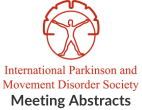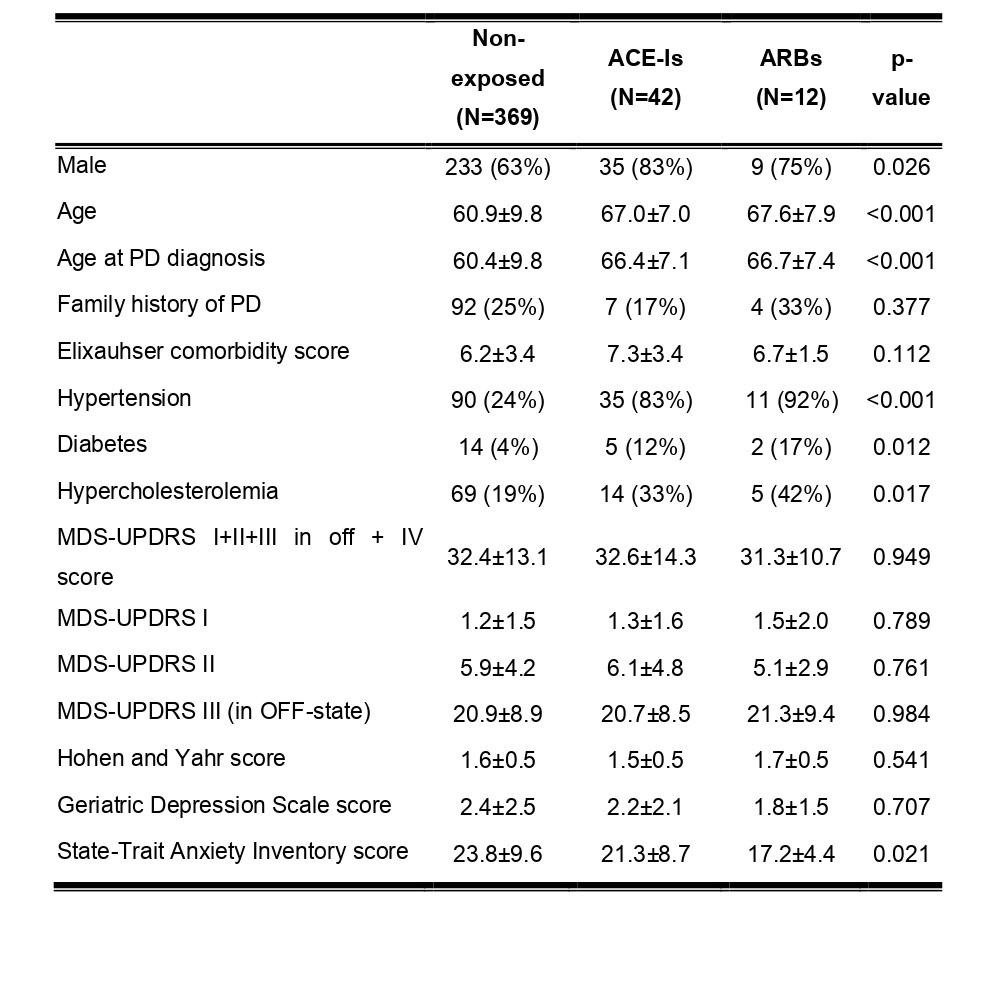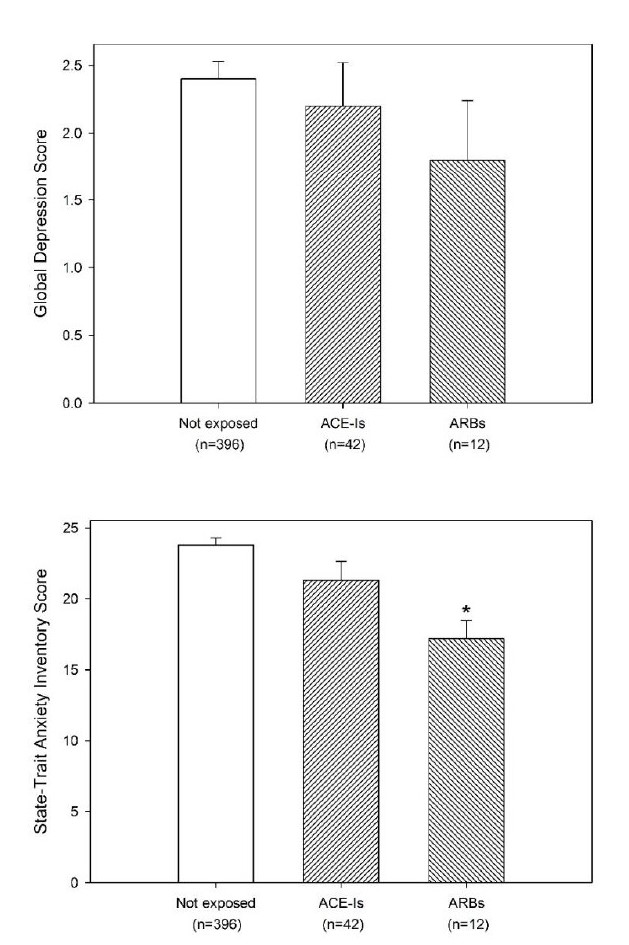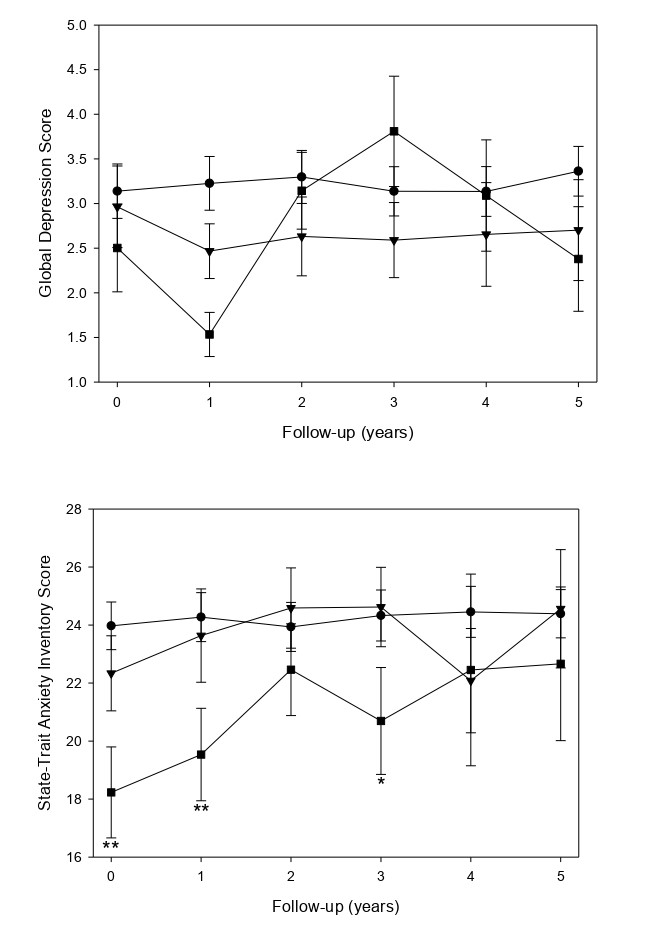Objective: The aim of this study was to explore the effects of Angiotensin II Type 1 receptor blockers (ARBs) and angiotensin-converting enzyme inhibitors (ACEIs) on anxiety and depression in PD.
Background: Mood disorders, including depression and anxiety, are often disturbing symptoms of Parkinson’s disease (PD). Various studies suggest that the cerebral Renin-Angiotensin System (RAS) might have a role in anxiety and depression development.
Method: Four hundred and twenty-three newly diagnosed PD patients free from antiparkinsonian treatment entered the study. Of them, 12 were treated with ARBs and 42 with ACE-Is. All 423 participants were evaluated using the State-Trait Anxiety Inventory (STAI) and Geriatric Depression Scale (GDS-15) tests and were monitored at baseline and for up to 5 years.
Results: At the beginning of the study (baseline visit), ARB-treated patients had lower anxiety STAI scores than those on ACE-Is or drug-free (Means ± standard errors= 17.2±1.3 vs. 21.3±1.3, or 23.8±0.5 respectively, p=0.021, ANOVA). Depression GDS scores were comparable across all groups, v.g., ARB-treated, ACE-I-treated, and untreated patients (Means ± standard errors= 1.8±0.4 vs. 2.2±0.3, and 2.3±0.11 respectively, p=0.863, ANOVA on logtransformed values). ARB-treated patients had lower STAI scores compared with the rest of the patients in the first and third follow-up years (p<0.01 and p=0.05, respectively). ACE-Is had no measurable effects. Depression scores were unaffected by any of the drugs throughout the study.
Conclusion: In our study, ARB-treatment reduced anxiety in PD. These results reinforce the suggested link between an abnormal RAS function and the development of this frequent symptom and warrant randomized clinical trials.
References: Aarsland, D., & Kramberger, M. (2015a). Neuropsychiatric Symptoms in Parkinson’s
Disease. Journal Of Parkinson’s Disease, 5(3), 659-667. doi: 10.3233/jpd-150604
Aarsland, D., Van Steenoven, I., Taylor, J., & Weintraub, D. (2015b). Neuropsychiatric
Aspects of Parkinson´s Disease. En J. Jankovic & E. Tolosa, Parkinson`s Disease &
Movement Disorders (6th ed., pp. 370 – 395). Philadelphia: Wolters Kluwer.
Barone, P., Poewe, W., Albrecht, S., Debieuvre, C., Massey, D., & Rascol, O. et al.
(2010). Pramipexole for the treatment of depressive symptoms in patients with
Parkinson’s disease: a randomised, double-blind, placebo-controlled trial. The Lancet
Neurology, 9(6), 573-580. https://doi.org/10.1016/s1474-4422(10)70106-x
Benicky, J., Sánchez-Lemus, E., Honda, M., Pang, T., Orecna, M., & Wang, J. et al.
(2010). Angiotensin II AT1 Receptor Blockade Ameliorates Brain
Inflammation. Neuropsychopharmacology, 36(4), 857-870.
https://doi.org/10.1038/npp.2010.225
Broen, M., Narayen, N., Kuijf, M., Dissanayaka, N., & Leentjens, A. (2016). Prevalence
of anxiety in Parkinson’s disease: A systematic review and meta‐analysis. Movement
Disorders, 31(8), 1125-1133. doi: 10.1002/mds.26643
Brownstein, D., Salagre, E., Köhler, C., Stubbs, B., Vian, J., & Pereira, C. et al. (2017).
Blockade of the angiotensin system improves mental health domain of quality of life:
A meta-analysis of randomized clinical trials. Australian &Amp; New Zealand Journal
Of Psychiatry, 52(1), 24-38. https://doi.org/10.1177/0004867417721654
Chrissobolis, S., Luu, A., Waldschmidt, R., Yoakum, M., & D’Souza, M. (2020). Targeting
the renin angiotensin system for the treatment of anxiety and
depression. Pharmacology Biochemistry And Behavior, 199, 173063.
https://doi.org/10.1016/j.pbb.2020.173063
Chuquilín-Arista, F., Álvarez-Avellón, T., & Menéndez-González, M. (2019). Prevalence
of Depression and Anxiety in Parkinson Disease and Impact on Quality of Life: A
Community-Based Study in Spain. Journal Of Geriatric Psychiatry And Neurology,
33(4), 207-213. https://doi.org/10.1177/0891988719874130
Corallo, F., Lo Buono, V., Palmeri, R., De Salvo, S., Berenati, M., & Greco, A. et al.
(2021). Anxiety, depression, and quality of life in Parkinson’s disease: the implications
of multidisciplinary treatment. Neural Regeneration Research, 16(3), 587.
https://doi.org/10.4103/1673-5374.293151 Ge, J., & Barnes, N. (1996). Alterations in
angiotensin AT1 and AT2 receptor subtype levels in brain regions from patients with
neurodegenerative disorders. European Journal Of Pharmacology, 297(3), 299-306.
https://doi.org/10.1016/0014-2999(95)00762-8
Genaro, K., Fabris, D., Fachim, H., & Prado, W. (2017). Angiotensin AT1 receptors
modulate the anxiogenic effects of angiotensin (5–8) injected into the rat ventrolateral
periaqueductal gray. Peptides, 96, 8-14.
https://doi.org/10.1016/j.peptides.2017.08.005
Han, J. W., Ahn, Y. D., Kim, W. S., Shin, C. M., Jeong, S. J., Song, Y. S., Bae, Y. J., &
Kim, J. M. (2018). Psychiatric Manifestation in Patients with Parkinson’s
Disease. Journal of Korean medical science, 33(47), e300.
https://doi.org/10.3346/jkms.2018.33.e300
Hommel, A., Meinders, M., Lorenzl, S., Dodel, R., Coelho, M., & Ferreira, J. et al. (2020).
The Prevalence and Determinants of Neuropsychiatric Symptoms in Late‐Stage
Parkinsonism. Movement Disorders Clinical Practice, 7(5), 531-542.
https://doi.org/10.1002/mdc3.12968
Kalia, L., & Lang, A. (2015). Parkinson’s disease. The Lancet, 386(9996), 896-912.
http://dx.doi.org/10.1016/S0140-6736(14)61393-3
Martinez‐Martin, P., Schrag, A., Weintraub, D., Rizos, A., Rodriguez‐Blazquez, C., &
Chaudhuri, K. (2019). Pilot Study of the International Parkinson and Movement
Disorder Society‐sponsored Non‐motor Rating Scale (MDS‐NMS). Movement
Disorders Clinical Practice, 6(3), 227-234. https://doi.org/10.1002/mdc3.12728
Mitsui, T., Kuroda, Y., & Adachi, K. (2010). Effect of angiotensin Ⅱ type 1-receptor
blocker candesartan on hypertensive Parkinson’s disease. Journal of Tokushima
National Hospital, 1, 1-5.
Otero‐Losada, M., Nobile, M., & Milei, J. (2017). The Angiotensin Affair: How Great
Minds Thinking Alike Came to a Historical Agreement. Renin-Angiotensin System –
Past, Present And Future, 3-12. https://doi.org/10.5772/67136
Pechlivanova, D., Krumova, E., Kostadinova, N., Mitreva-Staleva, J., Grozdanov, P., &
Stoynev, A. (2020). Protective effects of losartan on some type 2 diabetes mellitusinduced complications in Wistar and spontaneously hypertensive rats. Metabolic
Brain Disease, 35(3), 527-538. https://doi.org/10.1007/s11011-020-00534-1
Poewe, W., Gauthier, S., Aarsland, D., Leverenz, J., Barone, P., Weintraub, D., Tolosa,
E., Dubois, B. (2008). Diagnosis and management of Parkinson’s disease dementia.
International Journal Of Clinical Practice, 62(10), 1581-1587.
https://doi.org/10.1111/j.1742-1241.2008.01869.x
Prakash, K., Bannur, B., Madhavrao, C., & Saniya, K. (2019). Neurobehavioral Effects
of Losartan on Rotenone Induced Parkinsonism in Rats. Indian Journal Of Public
Health Research &Amp; Development, 10(9), 38. https://doi.org/10.5958/0976-
5506.2019.02398.2
Reijnders, J., Ehrt, U., Weber, W., Aarsland, D., & Leentjens, A. (2007). A systematic
review of prevalence studies of depression in Parkinson’s disease. Movement
Disorders, 23(2), 183-189. https://doi.org/10.1002/mds.21803
Saavedra J. M. (2017). Beneficial effects of Angiotensin II receptor blockers in brain
disorders. Pharmacological research, 125(Pt A), 91–103.
https://doi.org/10.1016/j.phrs.2017.06.017
Saavedra, J. (2021). Angiotensin Receptor Blockers Are Not Just for Hypertension
Anymore. Physiology, 36(3), 160-173. https://doi.org/10.1152/physiol.00036.2020
Sánchez-Lemus, E., Honda, M., & Saavedra, J. (2012). Angiotensin II AT1 receptor
blocker candesartan prevents the fast up-regulation of cerebrocortical
benzodiazepine-1 receptors induced by acute inflammatory and restraint
stress. Behavioural Brain Research, 232(1), 84-92.
https://doi.org/10.1016/j.bbr.2012.03.041
Salmani, H., Hosseini, M., Baghcheghi, Y., Moradi-Marjaneh, R., & Mokhtari-Zaer, A.
(2020). Losartan modulates brain inflammation and improves mood disorders and
memory impairment induced by innate immune activation: The role of PPAR-γ
activation. Cytokine, 125, 154860. https://doi.org/10.1016/j.cyto.2019.154860
Spielberger, C. (2010). State-Trait Anxiety Inventory. The Corsini Encyclopedia Of
Psychology. https://doi.org/10.1002/9780470479216.corpsy0943
Spielberger, C.D., Gorsuch, R., y Lushene, R. (1970). Manual for the StateTrait Anxiety
Inventory. Palo Alto, California: Consulting Psychologist Press.
Tashev, R., & Ivanova, M. (2018). Involvement of hippocampal angiotensin 1 receptors
in anxiety-like behaviour of olfactory bulbectomized rats. Pharmacological
Reports, 70(5), 847-852. https://doi.org/10.1016/j.pharep.2018.03.001
Tchekalarova, J., Ivanova, N., Pechlivanova, D., Atanasova, D., Lazarov, N., &
Kortenska, L. et al. (2014). Antiepileptogenic and neuroprotective effects of losartan
in kainate model of temporal lobe epilepsy. Pharmacology Biochemistry And
Behavior, 127, 27-36. https://doi.org/10.1016/j.pbb.2014.10.005
Trojano, L., & Papagno, C. (2017). Cognitive and behavioral disorders in Parkinson’s
disease: an update. II: behavioral disorders. Neurological Sciences, 39(1), 53-61.
https://doi.org/10.1007/s10072-017-3155-7
Tysnes, O., & Storstein, A. (2017). Epidemiology of Parkinson’s disease. Journal Of
Neural Transmission, 124(8), 901-905. https://doi.org/10.1007/s00702-017-1686-y
Vian, J., Pereira, C., Chavarria, V., Köhler, C., Stubbs, B., & Quevedo, J. et al. (2017).
The renin–angiotensin system: a possible new target for depression. BMC Medicine,
15(1). https://doi.org/10.1186/s12916-017-0916-3
Weintraub, D., & Mamikonyan, E. (2019). The Neuropsychiatry of Parkinson Disease: A
Perfect Storm. The American Journal Of Geriatric Psychiatry, 27(9), 998-1018.
https://doi.org/10.1016/j.jagp.2019.03.002
WHOCC – Guidelines. Whocc.no. (2021).
https://www.whocc.no/atc_ddd_index_and_guidelines/guidelines/.
Yesavage, J., Brink, T., Rose, T., Lum, O., Huang, V., Adey, M., & Leirer, V. (1982).
Development and validation of a geriatric depression screening scale: A preliminary
report. Journal Of Psychiatric Research, 17(1), 37-49. https://doi.org/10.1016/0022-
3956(82)90033-4
Yesavage, J., & Sheikh, J. (1986). 9/Geriatric Depression Scale (GDS). Clinical
Gerontologist, 5(1-2), 165-173. https://doi.org/10.1300/j018v05n01_09
Zhao, N., Yang, Y., Zhang, L., Zhang, Q., Balbuena, L., & Ungvari, G. et al. (2020).
Quality of life in Parkinson’s disease: A systematic review and meta‐analysis of
comparative studies. CNS Neuroscience & Therapeutics, 27(3), 270-
279. https://doi.org/10.1111/cns.13549
To cite this abstract in AMA style:
S. Bordet, L. Grasso, L. Udovin, G. Chevalier, M. Otero-Losada, F. Capani, S. Perez-Lloret. Angiotensin II Type 1 (AT1) receptor antagonists as potential candidates for anxiety treatment in Parkinson’s Disease [abstract]. Mov Disord. 2023; 38 (suppl 1). https://www.mdsabstracts.org/abstract/angiotensin-ii-type-1-at1-receptor-antagonists-as-potential-candidates-for-anxiety-treatment-in-parkinsons-disease/. Accessed July 15, 2025.« Back to 2023 International Congress
MDS Abstracts - https://www.mdsabstracts.org/abstract/angiotensin-ii-type-1-at1-receptor-antagonists-as-potential-candidates-for-anxiety-treatment-in-parkinsons-disease/



